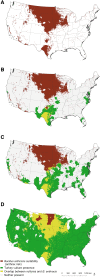Anthrax Surveillance and the Limited Overlap Between Obligate Scavengers and Endemic Anthrax Zones in the United States
- PMID: 34077293
- PMCID: PMC8563459
- DOI: 10.1089/vbz.2020.2747
Anthrax Surveillance and the Limited Overlap Between Obligate Scavengers and Endemic Anthrax Zones in the United States
Abstract
Anthrax is a zoonosis caused by the spore-forming bacterium Bacillus anthracis, with potential for high fatality rate, especially in herbivores. Upon host death, spores can enter the soil surrounding the carcass and be ingested by other animals feeding in the same location. Accordingly, surveillance to quickly identify and decontaminate anthrax carcasses is crucial to outbreak prevention. In endemic anthrax areas such as Texas and Africa, vultures are used as a surveillance tool for identifying presence and location of dead animals. However, many anthrax outbreaks in the United States have occurred in areas outside the ranges of both black and turkey vultures. Here, we used a longitudinal camera trap survey at carcass sites in southwestern Montana to investigate the utility of facultative avian scavengers on disease and carcass surveillance in a reemerging anthrax risk zone. From August 2016 to September 2018, camera traps at 11 carcass sites were triggered 1996 times by avian scavengers. While the majority were facultative avian scavengers such as corvids and eagles, our results suggest that facultative scavengers cannot replace vultures as a surveillance tool in this ecosystem due to their absence during the anthrax risk period (June to August), reduced search efficiency, or low flight patterns. We found that the conditions in Montana likely parallel systems elsewhere in the continental United States. Using ecological niche models of B. anthracis distribution overlaid with relative abundance maps of turkey vultures, we found that much of North Dakota, South Dakota, Minnesota, Wyoming, Nebraska, and Iowa have areas of anthrax risk, but low or absent turkey vulture populations. Without vultures in these areas, surveillance capacity is reduced, and it becomes more difficult to identify anthrax cases, meaning fewer carcasses are decontaminated, and consequently, outbreaks could become more frequent or severe.
Keywords: anthrax; corvids; obligate scavengers; turkey vultures; vultures; zoonosis.
Conflict of interest statement
No conflicting financial interests exist.
Figures






Similar articles
-
Potential Bacillus anthracis Risk Zones for Male Plains Bison ( Bison bison bison) in Southwestern Montana, USA.J Wildl Dis. 2019 Jan;55(1):136-141. doi: 10.7589/2017-09-234. Epub 2018 Jul 17. J Wildl Dis. 2019. PMID: 30016211 Free PMC article.
-
Competition between obligate and facultative scavengers and infection: vulture-jackal-anthrax dynamics in Etosha National Park.J Theor Biol. 2022 Mar 21;537:110981. doi: 10.1016/j.jtbi.2021.110981. Epub 2021 Dec 14. J Theor Biol. 2022. PMID: 34919935
-
Control and Prevention of Anthrax, Texas, USA, 2019.Emerg Infect Dis. 2020 Dec;26(12):2815-2824. doi: 10.3201/eid2612.200470. Emerg Infect Dis. 2020. PMID: 33219643 Free PMC article.
-
Spores and soil from six sides: interdisciplinarity and the environmental biology of anthrax (Bacillus anthracis).Biol Rev Camb Philos Soc. 2018 Nov;93(4):1813-1831. doi: 10.1111/brv.12420. Epub 2018 May 6. Biol Rev Camb Philos Soc. 2018. PMID: 29732670 Review.
-
Dropping dead: causes and consequences of vulture population declines worldwide.Ann N Y Acad Sci. 2012 Feb;1249:57-71. doi: 10.1111/j.1749-6632.2011.06293.x. Epub 2011 Dec 16. Ann N Y Acad Sci. 2012. PMID: 22175274 Review.
Cited by
-
Some Peculiarities of Anthrax Epidemiology in Herbivorous and Carnivorous Animals.Life (Basel). 2022 Jun 10;12(6):870. doi: 10.3390/life12060870. Life (Basel). 2022. PMID: 35743901 Free PMC article. Review.
-
Feral Swine as Indirect Indicators of Environmental Anthrax Contamination and Potential Mechanical Vectors of Infectious Spores.Pathogens. 2023 Apr 20;12(4):622. doi: 10.3390/pathogens12040622. Pathogens. 2023. PMID: 37111508 Free PMC article.
-
Review of techniques for the in-situ sterilization of soil contaminated with Bacillus anthracis spores or other pathogens.Res Microbiol. 2024 May-Jun;175(4):104175. doi: 10.1016/j.resmic.2023.104175. Epub 2023 Dec 21. Res Microbiol. 2024. PMID: 38141796 Free PMC article. Review.
-
Anthrax in Humans, Animals, and the Environment and the One Health Strategies for Anthrax Control.Pathogens. 2024 Sep 7;13(9):773. doi: 10.3390/pathogens13090773. Pathogens. 2024. PMID: 39338965 Free PMC article. Review.
References
-
- Anderson RP, Lew D, Peterson AT. Evaluating predictive models of species' distributions: Criteria for selecting optimal models. Ecol Model 2003; 162:211–232.
-
- Avery ML. Trends in North American vulture populations. Proc Vertebr Pest Conf 2004; 21.
-
- Bagamian KH, Alexander KA, Hadfield TL, Blackburn JK. Ante-and postmortem diagnostic techniques for anthrax: Rethinking pathogen exposure and the geographic extent of the disease in wildlife. J Wildl Dis 2013; 49:786–801. - PubMed
-
- Barandongo ZR, Mfune JKE, Turner WC. Dust-bathing behaviors of african herbivores and the potential risk of inhalational anthrax. J Wildl Dis 2017; 54:34–44. - PubMed
-
- Bellan SE. Applications of Data-Driven Modeling to Infectious Diseases in Africa: Anthrax in Wildlife and HIV in Humans. California, USA: UC Berkeley, 2012.
Publication types
MeSH terms
Grants and funding
LinkOut - more resources
Full Text Sources
Medical

